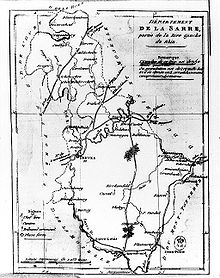Consistoire Trier

The Consistoire Trier , based in the city of Trier , was created like the Consistoire central israélite and twelve other regional consistories by Napoleon by an imperial decree of March 15, 1808. The areas on the left bank of the Rhine were incorporated into the territory of the French state until 1814 .
tasks
The consistories, which were given semi-state status, were supposed to regulate the internal affairs of the Jewish religious community based on the Protestant model . The consistory had to administer the cult, to encourage the Jews to exercise useful professions and to nominate the Jewish recruits to the authorities .
At the top of the three-tier hierarchical structure was the Consistoire central israélite (Central Consistory) in Paris , to which the regional consistories (Consistoires régionaux) were subordinate, to which the individual Jewish communities (communautés juives) were subordinate. The consistories had the task of supervising the practice of religion within the state laws and of setting and collecting taxes so that the organs of the Jewish denomination could meet their expenses.
Each regional consistory had a chief rabbi and four lay members who were elected by the Jewish notables of the affiliated communities. The Trier chief rabbi was Samuel Marx (1775–1827), an uncle of Karl Marx .
With the defeat of Napoleon in 1814, the areas on the left bank of the Rhine were redistributed among the German states and the French laws on the organization of Jewish residents continued to apply in the areas that had fallen to Prussia. In 1847 the first unified Prussian Landtag passed the law on the conditions of the Jews and abolished the Rhenish consistorial system ( Bonn , Krefeld and Trier).
area
The Trier Consistory was responsible for the Jewish communities in the Forêts , Sambre-et-Meuse and Sarre departments. In 1808, 3,553 Jewish citizens ( Citoyen ) lived in the départements .
Parishes (1808)
- Jewish community Trier , 261 people
literature
- Dictionnaire biographique des rabbins et autres ministres du culte israélite. France et Algérie, du Grand Sanhédrin (1807) à la loi de Séparation (1905) . Berg International Éditeurs, Paris 2007.
- Dieter Kastner (edit.): The Rhenish Provincial Parliament and the Emancipation of the Jews in the Rhineland 1825-1845 . A documentation in two parts (Rheinprovinz 2), Cologne / Bonn 1989, ISBN 3-7927-0909-0 .
